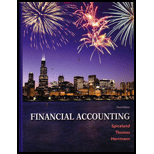
Requirement – 1
To calculate: The return on assets for both companies and compare with given companies.
Requirement – 1
Explanation of Solution
Return on total Assets:
It is a measure to evaluate the efficiency of company’s assets. It reports the profit earned as the percentage of total assets used in the business. A company’s
The formula to compute return on asset:
The return on assets for both companies is as follows:
Company H:
Company I:
Calculate the average total assets of Company H.
(1)
Calculate the average total assets of Company I.
(2)
Therefore, the return on assets of Company H and Company I is 5.7% and 13.8% respectively.
In this case, Company I has lower return on assets than Company A but higher than Company D. Company H has lower return on assets than Company A and Company D.
Requirement – 2
To calculate: The cash return on assets for both companies
Requirement – 2
Explanation of Solution
Cash return on assets:
It refers to the rate of cash generated from the investments in assets of company. It is relationship between the
The formula to compute cash return on assets:
The cash return on assets for both companies is as follows:
Company H:
Company I:
Therefore, the cash return on assets of Company H and Company I is 10.2% and 17.3% respectively.
In this case, Company I has lower cash return on assets than Company A but higher than Company D. Company H has lower cash return on assets than Company A and Company D.
Requirement – 3
To calculate: The cash flow to sales ratio and asset turnover ratio for both companies:
Requirement – 3
Explanation of Solution
Cash flows to sales:
It measures the cash generated from operating activities for each dollar of sales.
The formula to compute cash return on assets
Assets Turnover:
It’s a measure to evaluate the efficiency of total assets used in the business to generate sales during a certain period. Assets turnover reflects the net sales as the times of average total assets.
The formula to compute asset turnover
The cash flow to sales ratio and asset turnover ratio for both companies are as follows:
Cash flow to sales ratio:
Company H:
Company I:
Assets Turnover:
Company H:
Company I:
Therefore, the cash flow to sales ratio of Company H and Company I is 9.9% and 18.6% respectively, and assets turnover ratio of Company H and Company I is 1.0 times and 0.9 times respectively.
In this case, Company H and Company I has lower cash flow to sales than Company A but higher than Company D. Company H and I has lower assets turnover ratio than Company A and Company D.
Want to see more full solutions like this?
Chapter 11 Solutions
Financial Accounting
- Bridgeport Electronics completes job #389, which has a standard of 450 labor hours at a standard rate of $24.75 per hour. The job was completed in 480 hours, and the average actual labor rate was $23.90 per hour. What is the labor efficiency (quantity) variance? (A negative number indicates a favorable variance and a positive number indicates an unfavorable variance.) Answerarrow_forwardI am looking for the correct answer to this general accounting problem using valid accounting standards.arrow_forwardIn 2020, it cost Jason Manufacturing $14 per unit to produce component R8. In 2021, it has increased to $18 per unit. In 2021, Eastern Supplies has offered to provide component R8 for $11 per unit to Jason. As it pertains to the make-or-buy decision, which statement is true? a. Net relevant costs are $3 per unit b. Incremental revenues are $4 per unit c. Differential costs are $7 per unit d. Incremental costs are $4 per unitarrow_forward
- Please provide the answer to this general accounting question using the right approach.arrow_forwardThe Frida Corporation reported total manufacturing costs of $245,000; manufacturing overhead totaling $68,000 and direct materials totaling $57,000. How much is direct labor cost?arrow_forwardI need solution with step by step.....??????????????????????????arrow_forward
- At the beginning of the year, a company predicts total direct materials costs of $920,000 and total overhead costs of $1,150,000. If the company uses direct materials costs as its activity base to allocate overhead, what is the predetermined overhead rate it should use during the year?arrow_forwardCompute the required purchases for julyarrow_forwardCan you help me solve this general accounting question using the correct accounting procedures?arrow_forward

 AccountingAccountingISBN:9781337272094Author:WARREN, Carl S., Reeve, James M., Duchac, Jonathan E.Publisher:Cengage Learning,
AccountingAccountingISBN:9781337272094Author:WARREN, Carl S., Reeve, James M., Duchac, Jonathan E.Publisher:Cengage Learning, Accounting Information SystemsAccountingISBN:9781337619202Author:Hall, James A.Publisher:Cengage Learning,
Accounting Information SystemsAccountingISBN:9781337619202Author:Hall, James A.Publisher:Cengage Learning, Horngren's Cost Accounting: A Managerial Emphasis...AccountingISBN:9780134475585Author:Srikant M. Datar, Madhav V. RajanPublisher:PEARSON
Horngren's Cost Accounting: A Managerial Emphasis...AccountingISBN:9780134475585Author:Srikant M. Datar, Madhav V. RajanPublisher:PEARSON Intermediate AccountingAccountingISBN:9781259722660Author:J. David Spiceland, Mark W. Nelson, Wayne M ThomasPublisher:McGraw-Hill Education
Intermediate AccountingAccountingISBN:9781259722660Author:J. David Spiceland, Mark W. Nelson, Wayne M ThomasPublisher:McGraw-Hill Education Financial and Managerial AccountingAccountingISBN:9781259726705Author:John J Wild, Ken W. Shaw, Barbara Chiappetta Fundamental Accounting PrinciplesPublisher:McGraw-Hill Education
Financial and Managerial AccountingAccountingISBN:9781259726705Author:John J Wild, Ken W. Shaw, Barbara Chiappetta Fundamental Accounting PrinciplesPublisher:McGraw-Hill Education





